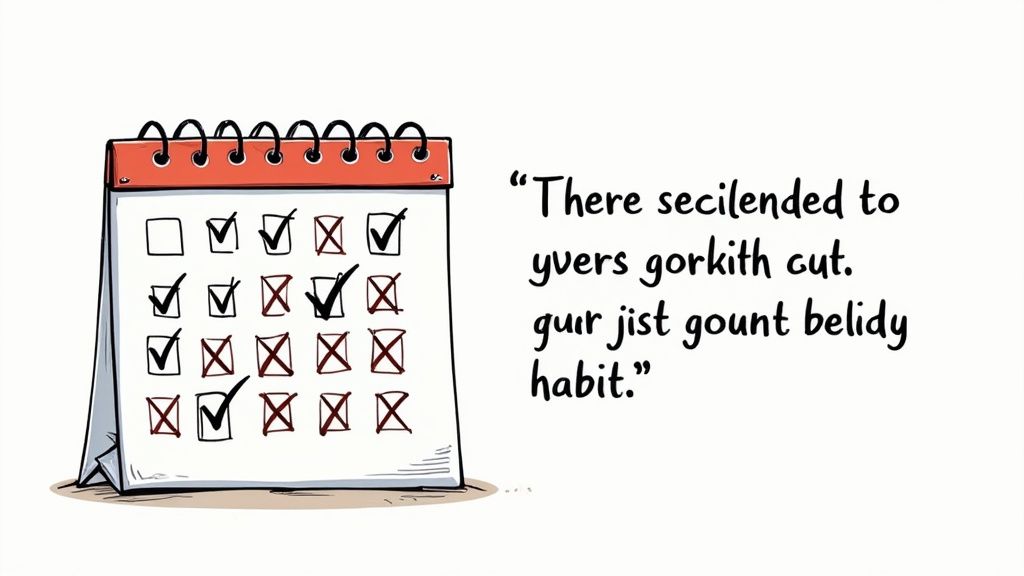How to Build Good Habits: The Step-by-Step Guide to Lasting Change


Understanding the Science Behind Lasting Change

Sucess with habbit bulding isn't just about trying hardr - it's about working with your brain's natral pattrns. When you undrstand how your brain forms and maintans habbits, you can make changes that actualy stick. Let's explor the scince that explans why some aproaches work while othrs fall short.
The Habit Loop: Cue, Craving, Response, Reward
Every habit follows a predictable four-step pattern called the habit loop. It starts with a cue - a trigger like a time of day or location that kicks things off. This cue sparks a craving, or desire, which leads to a response (the habit itself). Finally, the reward reinforces the behavior. For instance, smelling fresh coffee (cue) makes you want caffeine (craving), so you make a cup (response) and enjoy the taste and energy boost (reward).
Why Willpower Isn't Enough
Though willpower helps get habits started, it's a limited resource that eventually runs out - like trying to exercise on an empty stomach. The real key is understanding and working with the habit loop. By thoughtfully adjusting your environment and routines to support good habits, you can make positive behaviors more automatic and less dependent on sheer determination.
Setting Realistic Expectations: The Key to Long-Term Success
Many people give up on habits because they expect too much too soon. Research from the World Economic Forum shows it takes between 7-15 weeks to build a strong habit, with 80% of people succeeding within this timeframe. Around 75% develop solid habits within 10 weeks. This means patience and small steps are essential. Rather than aiming for overnight transformation, focus on steady progress. Celebrate small wins and don't let occasional slip-ups derail you. Remember - lasting change comes from understanding your brain's needs, setting realistic goals, and staying consistent over time.
Crafting Your Personal Habit Blueprint
Creating lasting positive changes requires more than just good intentions - it needs a clear system designed specifically for you. Let's explore how to build your personal habit framework by selecting key behaviors, breaking them into manageable steps, and putting accountability systems in place.
Identifying Your Keystone Habits
Keystone habits are foundational behaviors that naturally lead to other positive changes. For example, regular exercise can improve your sleep quality, boost your energy levels, and enhance your mood - which then positively affects your work and relationships. By focusing first on these core habits, you can create momentum that makes other changes easier.
Breaking Down Ambitious Goals
Big goals often feel intimidating at first glance. The key is breaking them into small, daily actions you can consistently complete. If you want to write a novel, start with writing just one page each day. Think of it like climbing a mountain - each individual step is manageable, and they add up to major progress over time.
Creating Accountability Systems
Having support structures in place helps maintain momentum when motivation naturally fluctuates. Research shows that writing down goals increases success rates by 42%, while having an accountability partner boosts achievement by 70%. Even simple reminders about your new habits increase follow-through by 12%. For maximum impact, consider using habit tracking apps and documenting your progress - studies show 62% of people reach their goals when combining trackers with group support. Find additional research on behavior change here.
Building Your Blueprint Step-by-Step
Follow this structured approach to create your habit system:
Define your keystone habit: Select the one behavior that will create the most positive ripple effects
Set a SMART goal: Make it Specific, Measurable, Achievable, Relevant, and Time-bound
Break it down: Identify small daily actions that build toward your larger goal
Design your environment: Adjust your surroundings to support your new habit
Establish accountability: Put tracking and support systems in place
Track your progress: Monitor your actions and celebrate key milestones
By following these steps methodically, you'll transform your goals into concrete daily practices. Your personalized blueprint provides the structure and focus needed to make meaningful changes that last.
Engineering Your Environment for Success

The spaces around you directly shape your daily behaviors and habits. While most people focus solely on willpower, research shows that your environment plays an even bigger role in determining whether good habits stick. Smart habit-builders know this and deliberately set up their surroundings to make positive behaviors easier and negative ones harder.
Creating Powerful Habit Triggers
One of the most effective ways to build good habits is through environmental triggers - specific cues in your space that prompt desired actions. For instance, placing a water bottle on your desk reminds you to stay hydrated throughout the day. Setting out exercise clothes the night before makes morning workouts more likely. These physical reminders work because they create a clear link between a location or object and the habit you want to build.
Optimizing Your Physical Space
Small changes to your physical environment can have big impacts on your habits. A clean, organized workspace naturally encourages focus and productivity. Having healthy snacks front and center in your kitchen makes nutritious choices more automatic. Even simple acts like putting your phone in another room while working can dramatically reduce distractions. The key is identifying what environmental factors either help or hinder your goals.
Taming Your Digital Environment
Our digital spaces need just as much intentional design as our physical ones. With endless notifications and online distractions competing for attention, we must actively shape our tech environment to support good habits. This could mean using website blockers during work hours, turning off non-essential notifications, or carefully curating which content appears in your social media feeds.
Consider charging your phone outside your bedroom to prevent late-night scrolling. Use apps designed to boost focus and limit mindless browsing. Small changes to your digital setup can lead to big improvements in productivity and wellbeing.
Research published in Frontiers in Psychology found that habit strength grows significantly over three months when people consistently practice behaviors in supportive environments. The study showed that while willpower matters, having the right environmental setup is even more crucial for lasting habit change. This means focusing less on forcing yourself to change through sheer discipline and more on designing spaces that naturally encourage better choices.
Mastering the Psychology of Rewards
Good habits rely heavily on rewards for their formation and maintenance. The right rewards create positive associations that help cement desired behaviors into our daily routines. To use rewards effectively though, we need to understand their psychological impact and how to implement them without creating dependencies.
The Power of Incentives
External rewards can effectively kickstart new habits, similar to using treats during pet training to associate actions with positive outcomes. A compelling example comes from research across 40 elementary schools studying 8,000 children - offering short-term incentives doubled the number of kids eating fruits and vegetables at lunch. Most importantly, even after removing the rewards, consumption stayed significantly higher than baseline, demonstrating how initial rewards can create lasting behavioral change. Read more about this research here.
Transitioning to Intrinsic Motivation
While external rewards help start habits, the end goal is developing intrinsic motivation - finding genuine satisfaction in the activity itself. Consider learning an instrument: if you play only for others' praise, your motivation may fade when the praise stops. But when you truly enjoy making music, the activity becomes its own reward. This internal drive is essential for maintaining habits long-term.
Designing Effective Reward Systems
To build lasting habits with rewards that develop internal motivation, try these approaches:
Start Small, Think Big: Begin with frequent small rewards for consistent actions. As the habit takes root, slowly reduce external rewards while emphasizing the natural benefits of the behavior.
Pair Extrinsic with Intrinsic: Connect external rewards to activities you naturally enjoy. For example, treat yourself to a healthy smoothie after exercise - a reward that aligns with your fitness goals.
Celebrate Milestones: Mark major progress with meaningful rewards that reinforce your efforts. This could mean buying a new book after reading consistently for a month or planning a weekend trip after reaching an important fitness goal.
Evolving Your Rewards
As your habits become stronger, your reward system should adapt. The need for external rewards naturally decreases as you begin deriving satisfaction directly from the activities themselves. This shift from external validation to internal fulfillment marks real progress in habit formation. While smart rewards won't make building habits effortless, they provide valuable support on your journey to lasting change.
Navigating Common Habit-Building Roadblocks

Creating lasting habits takes time and effort. While the path isn't always smooth, understanding common challenges and having strategies to address them can make a big difference in your success. Let's look at practical ways to overcome the most frequent obstacles.
Identifying Your Personal Barriers
The first step is getting clear on what specifically holds you back. Maybe you get distracted easily, doubt yourself, or lose motivation when things get difficult. By pinpointing your unique challenges, you can develop targeted solutions. For example, if distractions derail you, setting up a quiet workspace away from interruptions could help you stay focused.
Maintaining Consistency During Stress
Life inevitably gets hectic at times. When stress hits, even solid routines can fall apart. The key is building flexible habits that bend rather than break. Instead of trying to maintain perfection, focus on keeping some consistency - even if it means scaling back. A 20-minute workout beats skipping exercise altogether. This prevents the discouraging "all-or-nothing" mindset.
Recovering From Setbacks
Everyone slips up sometimes. What matters is how you handle those moments. Rather than seeing setbacks as failures, treat them as chances to learn and improve. Look at what triggered the slip, then adjust your approach. You might need to modify your environment, get more support, or revise your reward system. Remember that building habits is about steady progress, not perfection.
Managing Willpower Depletion
Willpower alone isn't enough for lasting change. Like a muscle, it gets tired with overuse. That's why creating systems and shaping your environment matter more than raw determination. Small changes like prepping healthy meals or leaving workout clothes by the door reduce the need for willpower by making good choices easier and more automatic.
Adapting to Unexpected Disruptions
Travel, illness, and schedule changes can easily throw off your routines. Having backup plans helps you stay consistent despite life's surprises. This could mean having a simple home workout ready when you can't get to the gym, or adjusting study times around shifting work demands. The more flexible your approach, the better you can maintain positive habits through ups and downs. Building this resilience is key to making changes that last.
Tracking Progress and Sustaining Success
Building good habits requires careful attention to measuring progress and maintaining motivation. Success comes from having clear systems to monitor your growth, acknowledge achievements, and refine your approach based on real results.
Choosing Your Tracking System
The most effective tracking method is one that fits naturally into your routine. Some people find success with simple paper-based tools like habit trackers in planners or wall calendars. Others prefer digital solutions like dedicated habit tracking apps that offer reminders, visualizations, and streak tracking features. The key is selecting an approach you'll stick with consistently.
The Power of Visual Progress
Seeing your progress mapped out provides powerful motivation. Whether through a simple chain of checkmarks on a calendar or detailed graphs showing your behavior patterns over time, visual feedback transforms abstract goals into clear evidence of your growth. This tangible record helps reinforce positive changes and build momentum.
Celebrating Milestones: Big and Small
Taking time to acknowledge your progress is crucial for staying motivated. Early in the habit-building process, celebrating small wins helps reinforce your commitment - maybe treating yourself to a favorite activity after a successful week. For bigger achievements like maintaining a habit for three months, consider more meaningful rewards that reflect the significance of your accomplishment. The goal is creating positive associations that strengthen your dedication.
Data-Driven Optimization
Beyond motivation, tracking provides valuable insights for improving your approach. By analyzing your behavior patterns, you can spot potential obstacles and adjust accordingly. For example, if you notice you consistently struggle with your habit on certain days, you can proactively plan solutions - whether adjusting your schedule, getting extra support, or strengthening environmental cues. This cycle of tracking, analyzing and refining is essential for long-term success.
Ready to take your coaching skills to the next level and build powerful habits that drive your success? Visit Coaching Hub for actionable insights, proven techniques, and inspiring stories to help you on your journey.